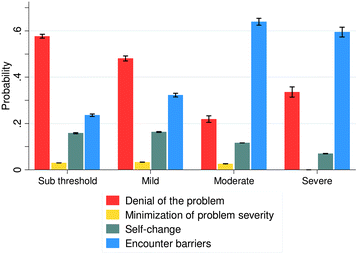Alcohol use disorder severity and reported reasons not to seek treatment: a cross-sectional study in European primary care practices
- PMID: 26264215
- PMCID: PMC4534056
- DOI: 10.1186/s13011-015-0028-z
Alcohol use disorder severity and reported reasons not to seek treatment: a cross-sectional study in European primary care practices
Abstract
Background: Alcohol use disorders are among the mental disorders with the lowest treatment rates. Increasing the treatment rates requires insight on the reasons why patients do not seek treatment. This study examined self-reported reasons for not seeking treatment and their association with alcohol use disorder severity among primary health care patients diagnosed with an alcohol use disorder.
Methods: Alcohol use disorders, health service utilization, and reasons for not seeking treatment were assessed via interviews on regionally representative samples of primary care patients from 6 European countries (Italy, Germany, Hungary, Latvia, Poland and Spain, total N = 9,098). Additionally, general practitioners had to fill in a questionnaire assessing their patients' alcohol use and alcohol use disorders. A multinomial logistic regression was performed to investigate the association between reasons for not seeking treatment and alcohol use disorder severity.
Results: Of 1,008 patients diagnosed with an alcohol use disorder (via general practitioner or patient interview) in the past 12 months, the majority (N = 810) did not receive treatment and 251 of those gave a reason for not seeking treatment. The most frequent reason was 'lack of problem awareness' (55.3% of those who responded), the second most common response was 'stigma or shame' (28.6%), followed by 'encounter barriers' (22.8%) and 'cope alone' (20.9%). The results indicated lower probabilities of reporting 'denial' and higher probabilities to report 'encounter barriers' as alcohol use disorders severity increases. However, both trends were discontinued for patients with severe alcohol use disorders.
Conclusions: Particularly at lower levels of alcohol use disorder severity, a lack of problem awareness prevents patients from seeking treatment. Routinely alcohol consumption monitoring in primary care practices could help primary and secondary prevention of alcohol use disorders and increase treatment coverage.
Figures



References
-
- Rehm J, Shield K, Rehm MX, Gmel G, Frick U. Alcohol consumption, alcohol dependence and attributable burden of disease in Europe: Potential gains from effective interventions for alcohol dependence. Toronto, Canada: Centre for Addiction and Mental Health; 2012.
-
- Shield K, Rylett MJ, Gmel G, Rehm J, World Health Organization Regional Office for Europe . Status report on alcohol and health in 35 European countries. Copenhagen: WHO Regional Office for Europe; 2013. Trends in alcohol consumption and alcohol-attributable mortality in the EU in 2010.
Publication types
MeSH terms
LinkOut - more resources
Full Text Sources
Other Literature Sources
Medical
Miscellaneous

